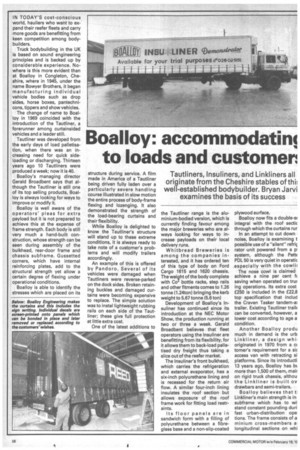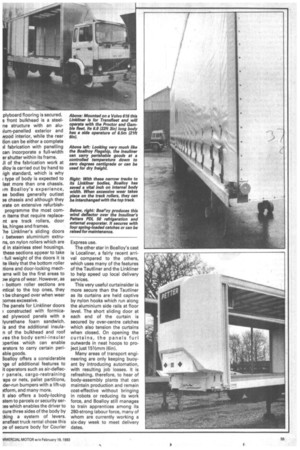Boalloy: accommodatini to loads and customer
Page 60

Page 61

If you've noticed an error in this article please click here to report it so we can fix it.
Tautliners, Insuliners, and Linkliners all originate from the Cheshire stables of thil well-established bodybuilder. Bryan Jarvi examines the basis of its success
IN TODAY'S cost-conscious world, hauliers who want to expand their reefer fleets and carry more goods are benefitting from keen competition among bodybuilders.
Truck bodybuilding in the UK is based on sound engineering principles and is backed up by considerable experience. Nowhere is this more evident than at Boalloy in Congleton, Cheshire, where in 1945, under the name Bowyer Brothers, it began manufacturing individual vehicle bodies such as drop sides, horse boxes, pantechnicons, tippers and show vehicles.
The change of name to Boalboy in 1969 coincided with the introduction of the Tautliner, a forerunner among curtainsided vehicles and a leader still.
Tautliner was developed from the early days of load palletisetion, when there was an increasing need for quick sideloading or discharging. Thirteen years ago 10 Tautliners were produced a week; now it is 40.
BoaIloy's managing director Gerald Broadbent says that although the Tautliner is still one of its top selling products, Boalloy is always looking for ways to improve or modify it.
Boalloy is well aware of the operators' pleas for extra payload but it is not prepared to achieve this at the expense of frame strength. Each body is still very much a hand-built construction, whose strength can be seen during assembly of the bulkhead, rear-door frame and chassis subframe. Gussetted corners, which have internal reinforcing plates, add to the structural strength yet allow a certain degree of flexing under operational conditions.
Boalloy is able to identify the stresses which are placed on its structure during service. A film made in America of a Tautliner being driven fully laden over a particularly severe handling course illustrated in slow motion the entire process of body-frame flexing and lozenging. It also demonstrated the strength of the load-bearing curtains and their flexibility.
While Boalloy is delighted to know the Tautliner's structure will stand up to these extreme conditions, it is always ready to take note of a customer's problems and will modify trailers accordingly.
An example of this is offered by Pandoro. Several of its vehicles were damaged when Tautliners were reverse-parked on the dock sides. Broken retaining buckles and damaged curtains were becoming expensive to replace. The simple solution was to instal lightweight rubbing rails on each side of the Tautliner; these give full protection at little extra cost.
One of the latest additions to the Tautliner range is the aluminium-bodied version, which is currently finding favour among the major breweries who are always looking for ways to increase payloads on their local delivery runs.
Whitbread Breweries is among the companies interested, and it has ordered ten of this type of body on Ford Cargo 1615 and 1620 chassis. The weight of the body complete with Co' bottle racks, step rails and other fitments comes to 1:26 tonne (1.24ton) bringing the kerb weight to 5.67 tonne (5,6 ton) Development of Boalloy's Insuliner has continued since its introduction at the NEC Motor Show, the production running at two or three a week. Gerald Broadbent believes that fleet operators using the Insuliner are benefitting from its flexibility, for it allows them to back-load palletised dry freight thus taking a slice out of the reefer market.
The Insuliner's front bulkhead, which carries the refrigeration and external evaporator, has a six-inch polyurethane lining and is recessed for the return air flow. A similar four-inch lining insulates the roof section but allows exposure of the roof frame work for fitting load restraints.
Its floor panels are in sandwich form with a filling of polyurethane between a fibreglass base and a non-slip-coated plywood surface.
Boalloy now fits a double-s( integral with the roof sectic through which the curtains rur In an attempt to cut down noise, Boalloy is examining t possible use of a "silent" refric rator unit powered from a pi system, although the Pette PDL 50 is very quiet in operatic especially with the cowlii
The nose cowl is claimed. achieve a nine per cent fi saving when operated on trur ing operations. Its extra cost £250 is included in the £22,8 top specification that includ the Craven Tasker tandem-a) trailer. Existing Tautliner trail( can be converted, however, a lower cost according to age a condition.
Another Boalloy produ much in demand is the urb Linkliner, a design whii originated in 1970 from a toner's requirement for a sic access van with retracting si platforms. Since its introducti 13 years ago, Boalloy has bt more than 1,500 of them, mair on rigid truck chassis, althou the Linkliner is built ov drawbars and semi-trailers.
Boalloy believes that ti Linkliner's main strength is in subframe which has to wii stand constant pounding duni fast urban-distribution ope tions. The frame consists of a minium cross-members al longitudinal sections on whi plyboard flooring is secured.
s front bulkhead is a steel ne structure with an alu 'Wm-panelled exterior and Nood interior, while the rear
don can be either a complete 31 fabrication with panelling can incorporate a full-width er shutter within its frame.
AI of the fabrication work at illoy is carried out by hand to ligh standard, which is why I type of body is expected to last more than one chassis.
Boalloy's experience, se bodies generally outlast se chassis and although they )rate on extensive refurbish programme the most cornn items that require replacent are track rollers, door ks, hinges and frames.
lie Linkliner's sliding doors between aluminium extru ns, on nylon rollers which are d in stainless steel housings. these sections appear to take full weight of the doors it is Iva likely that the bottom roller lions and door-locking mechsms will be the first areas to )10v signs of wear. However, as bottom roller sections are ntical to the top ones, they be changed over when wear :omes excessive.
rhe panels for Linkliner doors t constructed with formicaed plywood panels with a lyurethane foam sandwich. is and the additional insulan of the bulkhead and roof yes the body semi-insular verties which can enable erators to carry certain penable goods.
BoaHoy offers a considerable ige of additional features to it operators such as air-deflecr panels, cargo-restraining 'aps or nets, pallet partitions, der-run bumpers with a lift-up Worm, and many more.
It also offers a body-locking stem to parcels or security ser :es which enables the driver to cure three sides of the body by :king a system of levers.
ansfleet truck rental chose this pe of secure body for Courier Express use.
The other star in Boalloy's cast is Localiner, a fairly recent arrival compared to the others, which uses many of the features of the Tautliner and the Linkliner to help speed up local delivery services.
This very useful curtainsider is more secure than the Tautliner as its curtains are held captive by nylon hooks which run along the aluminium side rails at floor level. The short sliding door at each end of the curtain is secured by over-centre catches which also tension the curtains when closed. On opening the curtains, the panels furl outwards in neat hoops to project just 151/2mm (61n).
Many areas of transport engineering are only keeping buoyant by introducing automation, with resulting job. losses. It is refreshing, therefore, to hear of body-assembly plants that can maintain production and remain cost-effective without bringing in robots or reducing its work force, and Boalloy still manages to train apprentices among its 280-strong labour force, many of whom are currently working a six-day week to meet delivery dates.








































































































